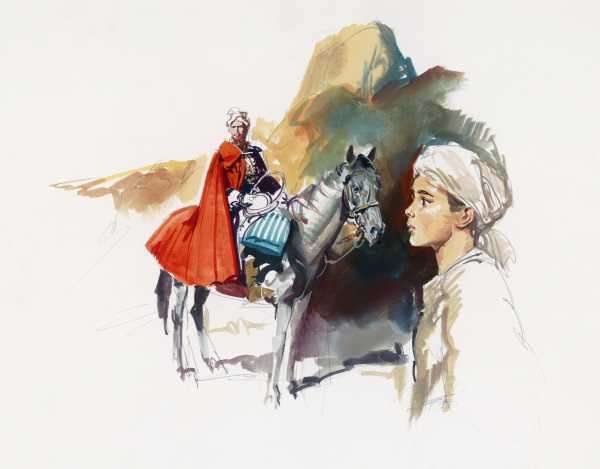
This month marks the 75th anniversary of India’s independence from British rule, with celebrations across a country that next year is slated to surpass China as the world’s most populous. Under Prime Minister Narendra Modi, leader of the Hindu nationalist Bharatiya Janata Party, the nation is undergoing a substantive shift in its understanding of its own past. “Today, at rallies of Hindu nationalist hard-liners,” reports the Washington Post, “Gandhi is routinely vilified as feeble in his tactics against the British.”
Indian historical reconsiderations extend beyond political rallies to the entertainment industry. “The real reason why we got independence was not because of Mr. Gandhi. That’s the fact,” declared popular Indian screenwriter Vijayendra Prasad. He ends his new summer blockbuster RRR with tributes to militant anti-British nationalists Subhas Chandra Bose, Vallabhbai Patel, and Bhagat Singh, the last “a folk hero who shot a British policeman and bombed the parliament building in Delhi before being hanged in 1931.”
Advertisement
It’s an interesting turn in Indian self-understanding, given the global, generations-long valorization of Gandhi as the apotheosis of peaceful civil disobedience, though perhaps an unsurprising one, given the BJP’s pugnacious Hindu nationalist agenda, which enjoys broad support across the country. It also presents a bit of an existential dilemma for America’s foreign policy establishment: should India’s thumotic swagger be celebrated as an extension of a more robust anti-colonialism, one that dismisses Western honoring of Gandhi as a manifestation of imperialistic power structures? Or should it be censured for its repudiation of post-national globalism and its hostility toward its own ethnic and religious minorities? How does one celebrate multiculturalism while still trying to impose a culture on others?
India, it would appear, is a complicated place, defying outsiders’ simplistic attempts to jam it into preconceived, politicized categories. Perhaps no Westerner has better understood this than English novelist and journalist Rudyard Kipling, who was born in India and spent a good part of his young adult life there. His widely hailed masterpiece Kim, published in 1901, offers a colorfully complex (and sympathetic) presentation of the mind-boggling diversity of Indian civilization. It’s also beloved by readers far and wide, ranked 78th on the Modern Library’s list of the 100 best English-language novels of the 20th century, and listed on the BBC’s 2003 poll of the U.K.’s “best-loved novel.”
I confess it took me three separate attempts, over more than a year, to get through the novel. That’s not so much because I didn’t find it interesting, but because I found it so deeply foreign. By that, I mean that the rich panoply of peoples, cultures, and practices described therein are so dizzyingly different that I would exhaust myself constantly pulling out my iPhone to query words like bairagi. And I’m not exactly a novice regarding South Asia: I’ve worked (briefly) in India, and have deployed multiple times to Afghanistan, which plays a significant role in Kim.
The story involves two main characters: the eponymous hero, an orphan of Irish emigres who lives as a vagabond on the streets of Lahore and is so immersed in local culture that few even realize he’s of European origin; and an aged Tibetan lama on a quest to find the legendary “River of the Arrow” so that he can free himself from Saṃsāra, the cyclical wheel of life. Kim becomes the lama’s disciple and decides to accompany him on his pilgrimage along the Grand Trunk Road. On the journey, Kim becomes embroiled in the “Great Game,” the political and diplomatic contest between the British and Russian Empire for control of central and south Asia. What follows is a tale filled with unique (and bizarre) characters and unexpected adventures.
If Kipling is known today by young American audiences, it’s less for Kim than for The Jungle Book and his 1899 poem “The White Man’s Burden,” which teachers assign as the exemplar of racist, imperialist propaganda. My Puffin Classics edition of Kim notes that Kiping “is, today, often thought to have been chauvinistically in favour of the British Empire … but that is a superficial judgement, based on the vigour of his writing and the fact that Kipling was certain of his values. Kipling loved India and its people: Kim is a perfect reflection of this love.”
Advertisement
I don’t know how anybody who reads this book could come away with any other impression. There are sympathetic discussions of Hindus, Sikhs, Buddhists, Jains, and Muslims. There are portrayals of troops of “long-haired, strong-scented [nomadic] Sansis with baskets of lizards and other unclean food on their backs, their lean dogs sniffing at their heels.” There are eccentric sorceresses who perform rituals involving the exotic spirits Zulbazan and Musboot, and Himalayan hill folk, “sallow, greasy, duffle-clad people” who live in mud and earth huts.
There are amusing anecdotal observations about Indian peasants, who “do not understand why, when they have paid for a magic piece of paper [a ticket], strangers should punch great pieces out of the charm. So, long and furious are the debates between travellers and Eurasian ticket-collectors.” And there are wonderful and morbid descriptions of Indian cities, such as Lucknow: “Kings have adorned her with fantastic buildings, endowed her with charities, crammed her with pensioners, and drenched her with blood.”
And there are poignant descriptions of the English from the perspective of the Indians. “Only the devils and the English walk to and fro without reason,” says one Indian. The “strong loneliness among white men,” preys upon the thoroughly Indian Kim. The novel speaks pejoratively of those English who are so uninterested in other cultures that they carelessly demean them as philistine and heathen. But it also depicts a friendly exchange between a District Superintendent of Police and a wealthy, elderly Rajput noblewoman in which the Englishman, well-versed in vernacular epithets to describe beauty, makes the woman double up “with mirth.”
Subscribe Today Get weekly emails in your inbox Email Address:
Perhaps Kipling put a little of himself in that last anecdote, hoping that he had ingested enough of India that he could elicit an appreciative laugh from locals. Certainly many prominent Indians have appreciated Kipling’s take on India at the turn of the last century. Jawaharlal Nehru, the independent nation’s first prime minister, called Kim one of his favorite books. Indian novelist Nirad C. Chaudhuri considered it the best story in English about India.
As much as Kipling imbibed India, he seemed to find it endlessly fascinating. And he loved it, while still, quite obviously, loving his own ancient English culture. And many Indians loved him for so carefully and devotedly studying and appreciating their culture. As my friend (and TAC contributing editor) Michael Warren Davis has argued, to truly appreciate another culture, one must first love one’s own. Kipling excelled at both, and likely because of that presented India to English-language readers on its own terms, in all of its fantastic alienness. That’s pretty much the exact opposite of the modern, deracinated ideologue who analyzes all cultures in the same boring, reductionist tropes of class, racial, sexual, and gender power structures.
I don’t know whether trading the peaceful activist Gandhi for the militant rebel Bhagat Singh as the nation’s hero is good for India. But I do know that any retelling of history that reduces other cultures and peoples to banal cliches—as “RRR” seems to do in its presentation of the British imperialists as irredeemable villains—tends to inflame, rather than alleviate tensions and grievances. Perhaps Hindu nationalists would do well to revisit Kim.
Advertisement
Sourse: theamericanconservative.com






